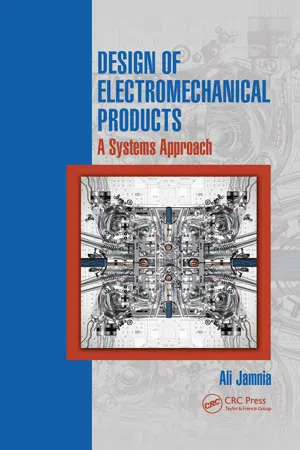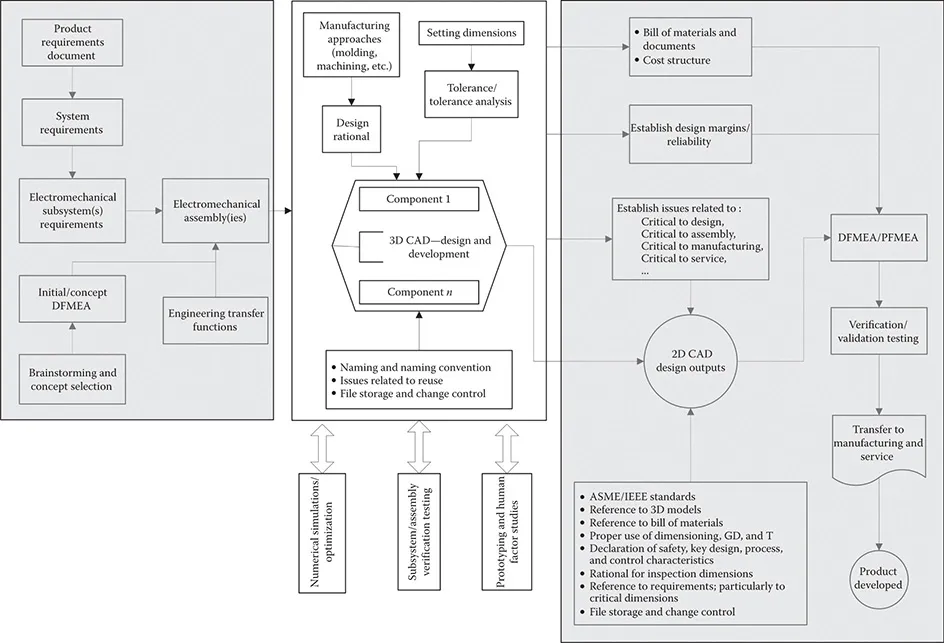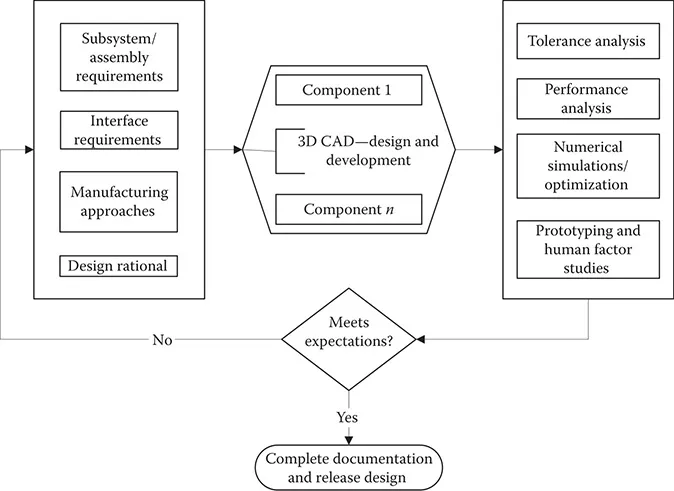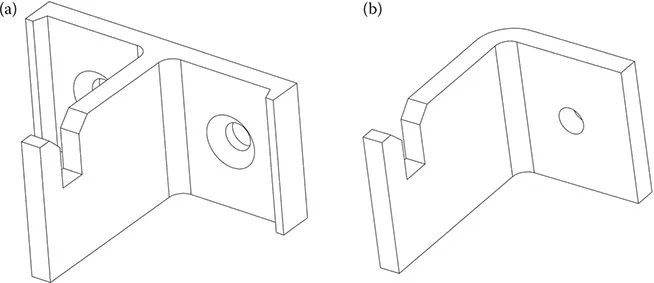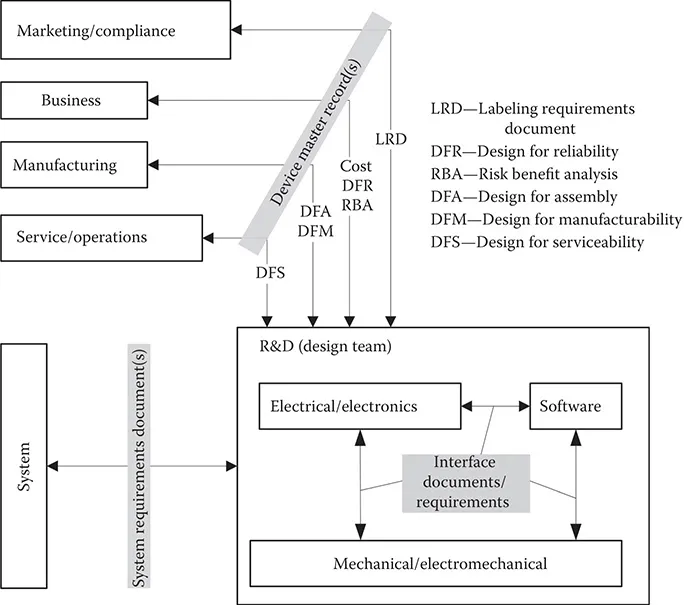Introduction
As a design engineer, I can say that to me the step to actually work on the 3D modeling is the most exciting step in product development. It is the step to actually design the so-called nuts and bolts of a product, and then see it materialize. It brings a sense of elation to me.
In Chapter 1, a product development roadmap was presented. Based on this map, by developing the transfer functions and assembly requirements, nearly one-third of the road has been traversed. Developing the virtual product constitutes the middle third; and the associated documentation and verifications make the last third as shown in Figure 7.1.
Before discussing the details of design approach, it should be mentioned that the outcome of design engineering activities is paperwork and not a product—as popularly believed. For this reason, it is important that ample time is given to documentation and providing information for the individuals who would be involved in sustaining the product and provide support. Should proper documentation not be maintained, product knowledge and information becomes tribal knowledge. This knowledge is lost when people move about either by retirement, different career paths, or attrition. A systems approach to product development always advocates preserving and maintaining product knowledge and information. Thus, it is appropriate to review needed documentations that will be released into a product’s design history file (DHF) to ensure that they provide the mindset and the rationale for the specific design decisions made.
In practice, development of major transfer functions takes place parallel to developing the mechanical look and feel of the product and/or subassemblies. However, the detailed design may begin in earnest when various subsystem behaviors have been well understood; that is, the transfer functions have been developed. Figure 7.2 provides an overview of the activities associated with developing the virtual product’s components, assemblies, subsystems, and finally the finished system—in short, the material covered in this chapter.
This design stage by its rather creative nature is iterative. It begins by examining the subsystem and/or assembly along with interface requirements. Next, manufacturing approaches along with design rationale are selected. In other words, if plastics are selected as the material over metal, and injection molding over machining, the rationale should be clearly documented. This is needed because depending on the manufacturing and selected material, the component and assembly designs (as well as associated costs) may be very different. To illustrate this point, consider the bracket shown in Figure 7.3. They both provide the same function. Part A may be manufactured using injection molding or machining; however, it may not be readily fabricated using sheet metal bending. Should sheet metal fabrication be of interest, the design should be modified to look like part B. Having a documented rational maintains design intent for future engineering support teams and helps any potential product upgrades.
Once (as shown in Figure 7.2) requirements have been decomposed into design specifications and the manufacturing approach is selected, components and assemblies may be designed using a variety of computer aided design (CAD) software. Depending on the assigned function of the component or assembly, there may be a need for tolerance and performance analysis, numerical simulation of either functions, or creating prototypes for human factor considerations and studies. Typically, this aspect of the design is an iterative process to converge to the desired configuration; and ultimately leading to release the design for manufacturing tooling. It should be noted that any requirements verification testing of assembly or subsystem requirements takes place using production tooling—and not using prototype units. If verification of requirements fails, this aspect of design must be repeated at least one more time. This broader process is demonstrated in Figure 7.4.
The process as represented in Figure 7.2 or Figure 7.4 is somewhat deceptive—or should I say oversimplified. It correctly suggests that the design team begins by decomposing assembly (or subsystem) requirements and develops design specifications. The reality is that to develop a comprehensive set of specifications, requirements, and inputs from other functions within R&D as well as from a variety of organizations outside of R&D should be taken into account and incorporated. In some organizations, the outcome of these activities and the decisions made as applicable to manufacture and service of the end product are documented in a Device Master Record document. The outcome and decisions concerning interfacing various functional inputs from within R&D are documented in a set of Interface Documents.
As shown in Figure 7.5 (and in no particular order), organizations that communicate design intent with R&D and their category of inputs are listed below:
1. Marketing as well as compliance (including regulatory) teams are labeling stakeholders. Labeling refers to any markings on the product (or shipped along with it) that communicates a message or a series of messages. An example of a label is a decal that provides information required by a regulatory body such as UL (Underwriters Laboratories), CE (Conformité Européenne, or European Conformity), or TUV (Technischer Überwachungsverein, or Technical Inspection Association). Another form of labeling is any marketing decal such as the product brand that may be printed or otherwise placed on the product. Product and shipping containers and any manuals also fall within this category. Often, the marketing team designs these documents; however, these designs are treated, maintained, and controlled as any other component design document.
2. The business team is focused on the financial aspect of the products and its impact on the so-called bottom line. Hence, one of the major and early requirements for any product is its projected cost of manufacture. This cost requirement should be properly cascaded to each subsystem and ultimately to each component. This factor influences the choice of manufacturing and production to a large extent. Associated with this cost sensitivity are influencers such as reliability. Clearly, the higher the product reliability, the lower the service and warranty costs. In addition to reliability, risk also plays an important role. No product is without risk; it so happens that some products have higher risks than others. It is the responsibility of the design team to identify risk factors and develop a risk benefit analysis of the product and identify safety-related components within the design.
3. Manufacturing team provides input and feedback on design for assembly (DFA) and design for manufacturability (DFM) concerns. Should the rules of DFA and DFM be properly followed, the overall cost of the product—both direct and indirect—will be lowered and optimized. However, while R&D receives information and input on DFA and DFM, it provides leadership and guidelines on what appropriate manufacturing approaches should be selected; and works closely with manufacturing to establish needed process and sets needed factors so that manufactured components meet design intent. An example of this R&D input is in injection molding components. Often, by reducing mold hold-time and pressure, an injection molding operation can save the cost of fabricating components; however, the price to be paid for this saving is higher part-to-part variability. R&D and manufacturing should partner to identify optimum process conditions that meet both design intent and manufacturing goals. Once identified, these process parameters should be captured in a related device master record.
4. Finally, the service team has a stake in the design process as well. They bring to table their expertise and know-how in service to arrange assemblies so that the service process is straightforward and time is not wasted to open the product and replace failed components. Similarly, R&D works with the service organization to provide effective diagnosis tools and codes such that a service personnel can easily and effectively identify a faulty component. As an example, many of the new computers may be considered. Once a malfunction is experienced, these newer units are equipped with a diagnosis software that may be executed at the startup of the computer. The system conducts a test of various critical components (such as memory, hard drive, or display) and reports if any issues are observed. Another example is an engine electronics module that is installed on many of the newer model automobiles. To identify any malfunctions, the mechanic attaches a diagnosis device to this module and within a short period of time, the issue is identified and located.
In addition to the showing the interrelationships between R&D’s design team and other stakeholders, Figure 7.5 points to the interrelationships between various functions within R&D. This inter-functional communication and collaboration is important even at some mundane levels. For instance, printed circuit board assemblies (PCBAs) typically designed by the electronics teams have to be mounted in enclosures designed typically by mechanical engineers. The simplest issue is placement of mounting holes and their size; who gets to dictate where these holes should...
